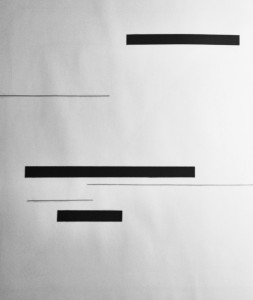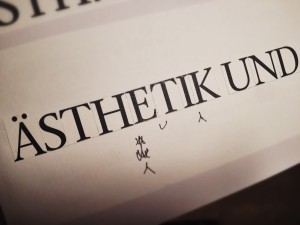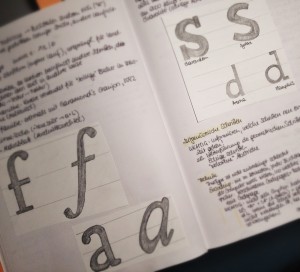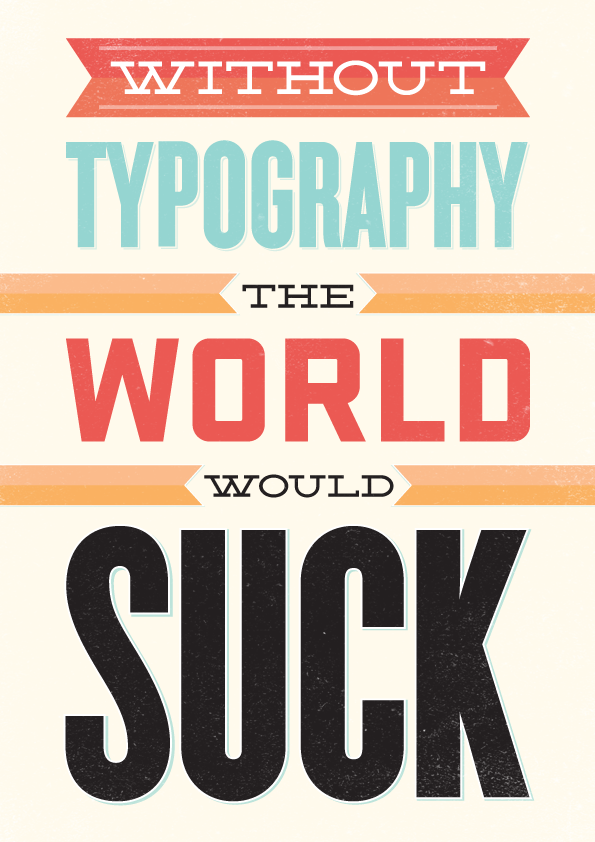say where now?
In October 2013, I drove to Germering – a small town outside of Munich – for the first time. The reason: the course Typografie intensiv (translation: “intense typography”) that was to take place there every five weeks or so for four semesters and ended this past weekend.
Is it even possible to summarize two years of learning in one blog post? Not in the least. And yet, not writing about these past years wouldn’t do the course justice – or the experience. So let me try.
take your time – and scribble
Over the course of 16 weekends, we learned quite a bit. First and foremost, typography is everywhere. (Believe me, if it wasn’t everywhere before, it will be once you study it for two years.) Also, using your computer too early in the design-process makes you slower, not faster – and your designs aren’t as good. Good design takes time!
We learned to scribble before doing anything else with a design idea. We learned how to build tension in a composition with lines and dots. How a page should look when it comes to proportions of text to white space.
Some of us – myself included – learned how to really use design software. We learned that center axis designs suggest nobility and should be used wisely, and capital letters ‘yell’ and should therefore be used sparingly – and when to use them anyway. And of course we learned about kerning and micro-typography.
We visited a printing company, some of us went on a typographic expedition of Zurich, and others even ate typefaces at a typography dinner. Yes, I said ‘ate’. We’re a weird bunch of typography nerds.
systems, grids, methods, applications
But not only that. We also learned what a grid really is and how to use one. (And that lots of designers out there don’t use them at all, amazingly.) We drew and wrote letterforms for practice.
We learned about colors – emotions they evoke psychologically, what they represent historically, and how to use them so they make sense for your design. We learned how to price our design. We learned how much work really goes into good corporate design; as a designer, you sometimes also have to be a mediator for your clients. We learned about systems and variations.
We learned about printing – which method to use when, their pros and cons, chemical compositions, and even the impact on the environment. We learned about materials: paper, images, printing machines; and about different applications of design: magazines, posters, CD covers, corporate design, homepages, text books, illustrated books, ads… you name it, we did it.
Last but not least, to get our diploma, we wrote a typographic study on a topic of our choice. And all of this next to working – either full time or freelance.
personal development
We learned that things that seem simple can be the ones you have the toughest time with (the ‘Zumthor’ poster, for example). And also: almost everybody thinks they’re weird; and if they don’t, they’re usually among the weirdest. (But we’re all pretty weird, like I said.)
We learned from each other. People whom I admire and sometimes wished my design was more like theirs struggled too, in other fields. Everyone has hidden talents that they hide well and don’t show until a certain level of trust has been reached. People who seem arrogant when you first get to know them turn out to be charming (remember that when you first meet me in person, ha!); and vice versa (not in our group of course!).
Our group dynamics were among the best of any group of people I’ve been a part of, ever. All of us come from different backgrounds; many from different cities. Our ages spanned 30 years. (I’m guessing, very roughly.) We grew up in different social systems or countries (the US, Russia, former East Germany; the country, the city, etc.). All of these things lead to different presuppositions and understanding when it comes to design. And yet I think I speak for all of us when I say we improved our skills and can use what we learned in the course for our own daily needs. Over the past two years I’ve made friends with a dozen others who not only see the nuances in design, but can also create them themselves. That is what I will miss the most: talking to and seeing these like-minded design-warriors on a regular basis.
emotional typography
Most of all, I’d have to say we learned about ourselves. I was forced to ask myself: ‘Where are my limits?’ ‘When does design flow out of me, when does it rob me of energy?’ ‘Why do I want to learn and do certain things while others get on my nerves?’ (Along with the usual, ‘What is it I really want to do with my life?’ and other first-world questions.)
In these last two years, I went through a rainbow of emotions: From being excited to go to the course to wanting to stay home and never touch a computer again. From not understanding that no one else saw typography everywhere and consequently wanting to tell the whole world about it, to thinking none of it was being noticed by anyone at all. From feeling like a student to feeling like a kid, to feeling like a professional, to feeling like a kid again. From hating the homework we had to do to loving the challenge. From tears of frustration to tears of joy.
really personal development
Parallel to the course, we all went through some personal things; I, for one, went freelance last year. But not only that. I’ve begun to speak my mind when it comes to things I disagree with (racism, sexism, bad design decisions, whatever). And I embarked on the journey to become a hand-lettering artist. None of this would have happened the way it did if I hadn’t taken this course. It made me feel like it was normal to care about design and helped me find a balance between detail-oriented, perfectionistic work and artistic, messy work – both of which are aspects of design and typography.
What can I say? I love typography. Because it’s the discipline where language and design come together to make something beautiful. Sure, sometimes one doesn’t quite let the other shine, other times one has to help the other to shine a bit more. But in essence, typography is what gets the message across. I love reducing the design-noise of our world and concentrating and promoting clear, legible designs. But most of all, I love people who also love these things. I haven’t said nearly all I’d like to, but this is a blog, not a novel, so let me just say one more thing: without typography, the world would suck.




 without typography the world would suck. by David Pomfret. dribbble.com/simpleasdavid
without typography the world would suck. by David Pomfret. dribbble.com/simpleasdavid